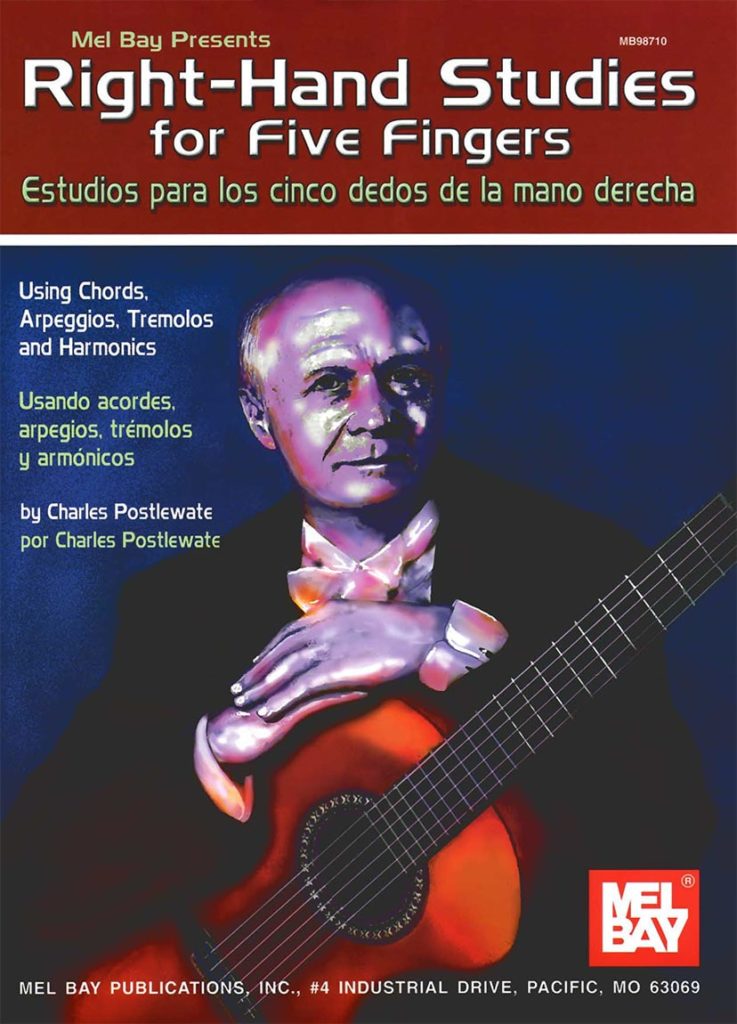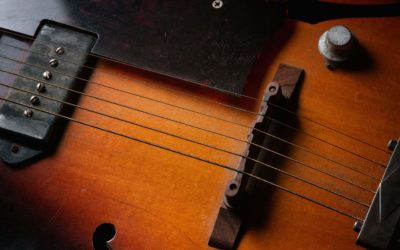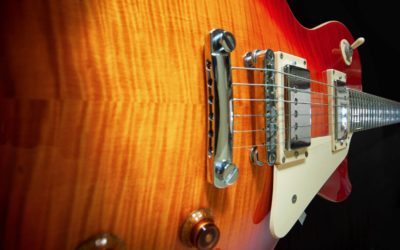Table of Contents
Book Review: “Right Hand Studies for Five Fingers” by Charles Postlewate
Many classic tomes on developing right hand fingerstyle technique will focus on using your thumb and three fingers (P-I-M-A), while often ignoring or mentioning only in passing the use of your fourth finger – (C). Right Hand Studies for Five Fingers focuses primarily on using all five fingers with a clear emphasis on the pinky as an equal member.
Measuring in at a scant 56 pages, the book is packed with a highly organized and progressive method for developing a strong right hand technique that incorporates the use of the right hand pinky.

Chord and Arpeggio Studies
The first part of the book is devoted to the study of chords and arpeggios. This is done in an interesting, progressive manner, starting initially with the thumb and one finger and eventually concluding with the thumb and all four fingers.
What makes this system unique is that all of the unused fingers are gently placed on the corresponding unused strings (preparation) which greatly aids in the relaxation and independence of the fingers.
Each of the studies uses a series of intervals (for bass note and one note) or chords (for bass and two or more notes) to play for each finger combination.
Personally, I use open strings, so that I could concentrate on the right hand, and will go through the book again with the recommended interval/chord examples (as I originally did with the initial studies). I would recommend doing the same, as the purpose of the book is to develop the right hand, not learning different harmonic fingerings.
While all of the previous finger combinations had one page devoted to them, the four finger combinations have seven pages of examples and can easily be considered the main focus of the book. Lots of various combinations and techniques are employed.
One downside is that several of the bass note examples have you detune your low “E” string to “D”. I’m not a fan of having to constantly change the tunings of my strings as I work through material.
Tremelo Studies
Studies one and two deal with m-i and a-m-i, respectively, then the next six studies all focus on tremolos using c-a-m-i and variations. Nothing profound here, just your “standard” tremelo studies, only this time using all five fingers.
Right Hand Harmonics Studies
Fans of Lenny Breau’s use of Harmonics will find this section to be of interest, as it focuses on the use of the little finger to play the string while touching the harmonic node with your index finger. The examples progress in a similar manner as the previous subject matter, increasing the “density” of the examples as it proceeds. This is all about the playing of one Harmonic in various arpeggio groupings and not the “Cascading Harmonics” of Lenny Breau fame.
Developing the Melody Fingers
This is another section that fans of Lenny Breau will find appealing, as it focuses on the use of the “c” finger to bring out the melody in various examples.
Preparation Studies for Specific Pieces
This material will appeal primarily to Classical Guitarists, as it explains the use of various five finger techniques as applied to specific pieces in the classical repertoire. Examples of pieces by Sor, Torroba and Villa-Lobos are explored.
Chromatic Variations of Progressions
This section introduces Chromatic chord progressions to be used instead of the diatonic ones introduced in the first section. A nice touch, but really not necessary.
DVD
There is a DVD available that shows examples of various Classical pieces using the five finger technique, as well as a section devoted to showing the examples using the “c” finger in the arpeggios from this book. The examples are shown “straight on”, as well as a view from behind the hand to see how the fingers are planted and released.
http://www.charlespostlewate.com/disc.html
Summary
Since I’ve switched over to a 7 string Hybrid guitar, I’ve decided to retool my techniques and remap the fingerboard – to best make use of the new instrument, and that led me to want to work harder on my “c” finger. Although I’ve used it in the past to play five note chords, I’ve never really pursued it to make it a major part of my overall technique.
While searching out material to increase my “c” strength and versatility, this book stood out as being well organized and well conceived. Although primarily for Classical guitar, finger stylists of any genre will find the examples to be challenging and an asset to their personal technique.
Surprisingly, the “hardest” part of the studies was the placing of the “non-used” fingers on their corresponding strings. Yet, this brought great results – as my fingers learned to be more relaxed, and the independence gained was quite noticeable!
My confidence in using my “c” finger has increased dramatically in a fairly “short” time with the usage of this book. I usually spend a couple of hours each day practicing the examples, and my hand feels stronger and more independent when I’m finished.
My main gripe with the book is that there are no studies that involve scales. I see this as a major shortcoming, as the book is already fairly short and the inclusion of scale studies could easily have been incorporated – even at the expense of replacing “unnecessary” sections such as “Chromatic Variations of Progressions”.
I would definitely recommend this book to all fingerstyle players, in particular fans of Lenny Breau and musicians looking to expand their right hand technique.
Final Words
I’d like to take a moment to remind everyone that my book is on sale for the month of July! I would also like to thank everyone who has purchased it! I appreciate your interest and support!





Thanks for your blog, nice to read. Do not stop.
Thank you for the kind words! I will continue… and hopefully with a more consistent schedule… 🙂